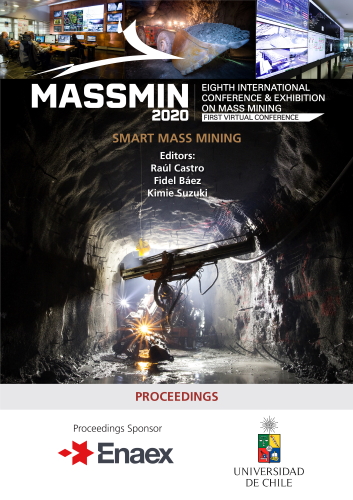Marker design and calibration for Carrapateena sub level and block cave with a focus on fines migration an far field flow

|
Authors: Hocking, R; Fargher, M; Chester, C |
This paper is hosted with the kind permission of Lulea University of Technology, International Conference & Exhibition on Mass Mining, 2024.
DOI https://doi.org/10.36487/ACG_repo/2063_33
Cite As:
Hocking, R, Fargher, M & Chester, C 2020, 'Marker design and calibration for Carrapateena sub level and block cave with a focus on fines migration an far field flow', in R Castro, F Báez & K Suzuki (eds), MassMin 2020: Proceedings of the Eighth International Conference & Exhibition on Mass Mining, University of Chile, Santiago, pp. 489-504, https://doi.org/10.36487/ACG_repo/2063_33
Abstract:
Carrapateena is mined by the sub level cave method, with studies underway on its transition to a block cave. There is a large amount of weaker cover sequence at Carrapateena above the orebody, and the prediction of the flow of this material is extremely important for understanding the Ore Reserve. As flow modelling has increased in complexity, there has been little focus on how to calibrate flow models and how to set up the marker design within the cave to improve the knowledge of the material flow in cave mines, with a particular focus on Far field flow (>100 m from the draw points). This paper discusses the design of the monitoring at Carrapateena, which includes grade measurement, marker installation and observations in the field to give measurements that can assist calibration. It also discusses how this information can be used to assist flow model calibration and the ultimate understanding of the flow of this fine material. A scorecard method is suggested to use all measurements ranging from grade information to marker data, which can be tracked through the Life of Mine, forming a transparent calibration method. The aim of this work is to better predict fines migration and improve estimation for Carrapateena, where a strong focus is needed on flow.
References:
Brunton, I, Lett, JL, Sharrock, GB, Thornhill, T & Mobilio, B 2016, ‘Full scale Flow Marker Experiments at Ridgeway Deeps and Cadia East Operations’.
Brunton, I, Fraser, SJ, Hodgkinson JH & Stewart, PC 2010, ‘Parameters influencing full scale sublevel caving material recovery at Ridgeway gold mine’.
Brunton, I 2008, ‘The Impact of Blasting on Sublevel Caving Material Flow Behaviour and Recovery’, PhD thesis, University of Qld, Brisbane.
Bull, G & Page, C H 2000, ‘Sublevel Caving – Today Dependable Low Cost Ore Factory’, in MassMin 2000 Conference Proceedings, Ed. Chitombo G., ISBN 875776 76 9, AusIMM, Melbourne.
Campbell, AD 2018, ‘Effects of blast ring burden and explosive density on fragmentation and ore recovery in sublevel cave mines’, in Y Potvin & J Jakubec (eds), Proceedings of the Fourth International Symposium on Block and Sublevel Caving, Australian Centre for Geomechanics, Perth, pp. 457-470.
Campbell, AD & Power, GR 2016, ‘Increasing net present value by a third at an operating sublevel cave mine using draw strategy optimisation’, in C Carr & G Chitombo (eds), Proceedings of MassMin 2016, The Australasian Institute of Mining and Metallurgy, Melbourne, pp. 167–174.
Castro, R, Hekmat, A, Fuentes, M, Armijo, F & Rodriguez, F 2016, ‘FlowSim – A versatile flow simulation tool to quantify extraction and design alternatives for block caving’ in C Carr & G Chitombo (eds), Proceedings of MassMin 2016, The Australasian Institute of Mining and Metallurgy, Melbourne, pp. 645–652.
Diering, T, Ngidi, SN, Bezuidenhout, JJ & Paetzold, HD 2018, ‘Palabora Lift 1 block cave: understanding the grade behaviour’, in Y Potvin & J Jakubec (eds), Proceedings of the Fourth International Symposium on Block and Sublevel Caving, Australian Centre for Geomechanics, Perth, pp. 91-106, .
Diering, T, Richter, O& Villa, D 2010, ‘Block Cave Production Scheduling Using PCBC, SME annual meeting’, Phoenix, Preprint 10-097.
Diering, T 2007, ‘Template mixing: A depletion engine for block cave scheduling’, in EJ Magri (ed.), Proceedings of the 33rd International Symposium on Application of Computers and Operations Research in the Mineral Industry, Santiago, pp. 313–320.
Garces, D, Viera, E, Castro, R & Melendez, M 2016, ‘Gravity Flow Full-scale Tests at Esmerelda Mine’s Block – 2 El Teniente’, in C Carr & G Chitombo (eds), Proceedings of MassMin 2016, The Australasian Institute of Mining and Metallurgy, Melbourne.
Hocking R & Masters S, 2020 ‘Carrapateena Mineral Resources and Ore Reserves as 31 May 2020’.
Hocking, R, Balog, G, Omerod, T & Pearce, H 2018, ‘Early Cave Management at Carrapateena SLC’, Caving 2018, Vancouver Canada.
Napier Munn 2002, ‘An introduction to comparative Statistics and Experimental Design for Mineral engineers’, 2nd Edition Version 4.13 JKMRC, Queensland.
Pierce M 2010, ‘A Model For Gravity Flow Of Fragmented Rock In Block Caving Mines’, PhD Thesis, Sustainable Minerals Institute, The University of Queensland.
Power, G 2012, ‘Optimizing caving recovery using comparative draw planning strategies and PGCA flow modelling software’, Proceedings of MassMin 2012, Canadian Institute of Mining, Metallurgy and Petroleum, Westmount.
Power, G 2004, ‘Full Scale SLC Draw Trials at Ridgeway Gold Mine’, Proceedings of MassMin 2004, Chilean Engineers Institute, Santiago, Chile.
Sharrock, GB, Beck, D, Booth, G & Sandy, M 2004, Simulating gravity flow in sub-level caving with cellular automata’, in A Karzulovic & A Alfaro (eds), Proceedings of MassMin 2004, Chilean Engineers Institute, Santiago, pp. 189–194.
Villa, D 2012, Calibration of A Mixing Model for Sublevel Caving, Masters’ thesis UBC.
Wilson, ML, Van Hout, GJ, Dean, FF 2018, Testing the suitability of radio frequency identification cattle tags for tracking block cave progression, Caving 2018 Vancouver Canada.
© Copyright 2025, Australian Centre for Geomechanics (ACG), The University of Western Australia. All rights reserved.
View copyright/legal information
Please direct any queries or error reports to repository-acg@uwa.edu.au
View copyright/legal information
Please direct any queries or error reports to repository-acg@uwa.edu.au
